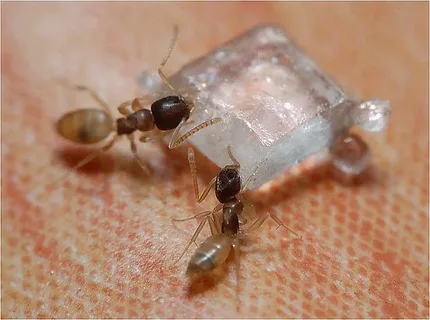Sugar ants—those tiny, persistent creatures that seem to invade your kitchen at the mere sight of a crumb—are a common nuisance in homes worldwide.
Despite their small size, they can quickly turn a peaceful space into a constant battle zone. The good news? You don’t have to put up with them forever.
By understanding the behavior of sugar ants and using effective control methods, you can reclaim your home from these pesky invaders.
In this guide, we’ll explore how to kill sugar ants and prevent future infestations.
What Are Sugar Ants?
Sugar ants, often referred to as odorous house ants (due to their smell when crushed), are attracted to sugary food sources.
These small, dark brown or black ants are typically found in kitchens, pantries, and anywhere food is left exposed.
Unlike other types of ants that build large mounds outside, sugar ants tend to build nests inside walls or under floors, making them tricky to spot.
While sugar ants are not harmful to humans directly, their presence can be an inconvenience and, over time, they can become a bigger problem if not addressed properly.
Step 1: Identify the Source
Before you start eliminating sugar ants, it’s important to identify where they are coming from.
Typically, these ants follow a trail to and from a food source, often leaving behind a chemical trail that leads other ants straight to the bounty.
- Trace the Ants’ Path: Start by watching where the ants are coming from and following them back to their nest or entry point. This could be cracks in walls, gaps in doors, or spaces around windows.
- Find the Nest: In some cases, the nest may be visible inside your walls, under the floorboards, or in other hidden spaces.
Once you locate the source or the entry point, you can take steps to eliminate the ants more effectively.
Step 2: Clean Thoroughly
Sugar ants are scavengers that seek out sugary and greasy substances. If you want to make your home less attractive to them, start by eliminating any food sources.
- Clean Up Food Crumbs: Wipe down countertops, sweep floors, and clean up any crumbs or spilled food. Don’t forget to clean areas behind appliances, where food debris can accumulate.
- Seal Containers: Store food in airtight containers to prevent ants from accessing it.
- Empty Garbage Regularly: Make sure trash cans are emptied frequently and tightly sealed to avoid attracting ants.
The cleaner you keep your home, the less appealing it will be to sugar ants.
Step 3: Natural Remedies to Kill Sugar Ants
If you’re looking for a natural, non-toxic solution to kill sugar ants, there are several options available that can be just as effective as chemical solutions.
- Vinegar Solution: Mix equal parts white vinegar and water in a spray bottle. Spray this solution directly on ants and along their trails. Vinegar disrupts the ants’ scent trails and can kill them on contact.
- Diatomaceous Earth (Food-Grade): This fine powder is made from the fossilized remains of diatoms. When ants come into contact with it, the powder causes dehydration, eventually killing them. Sprinkle it along ant trails, around entry points, or in areas where ants are frequently seen.
- Cinnamon or Cloves: Ants are repelled by strong smells. Sprinkling cinnamon or placing whole cloves around your home can deter ants from entering. You can also use cinnamon oil or clove oil mixed with water as a natural repellent.
- Lemon Juice: The acidity of lemon juice disrupts ants’ scent trails, making it difficult for them to navigate. You can spray lemon juice directly on ants or around the areas where they’re entering your home.
Step 4: Chemical Solutions for More Severe Infestations
For larger infestations, natural methods might not always be enough.
In such cases, chemical solutions can be effective, though it’s important to use them carefully, especially if you have pets or young children in the home.
- Ant Baits: Ant baits are one of the most effective ways to target sugar ants. These baits are designed to attract ants, who then carry the poisoned bait back to the nest. Over time, this kills the colony, including the queen. Be patient, as it can take several days or weeks for the colony to be completely eradicated.
- Ant Sprays: There are various commercial insecticide sprays available that can kill ants on contact. These are useful for eliminating visible ants quickly, but they do not address the nest, so they may not provide a long-term solution.
- Ant Powder or Granules: These can be sprinkled along ant trails and around the entry points to your home. The powder typically contains chemicals like borax or permethrin, which are toxic to ants.
Step 5: Seal Entry Points
Once you’ve dealt with the ants inside your home, it’s crucial to prevent them from coming back. Sugar antscan enter through the tiniest of gaps, so sealing up entry points is essential.
- Caulk Cracks and Gaps: Use caulk to seal cracks around windows, doors, and walls.
- Replace Weatherstripping: Make sure doors and windows have intact weatherstripping to prevent ants from entering.
- Install Ant Barriers: Some homeowners opt for physical barriers, like sticky ant tapes, along the perimeter of their home to prevent ants from crossing into the interior.
Step 6: Prevent Future Infestations
To keep sugar ants from coming back, you need to maintain a clean environment and keep your home sealed against future invasions.
- Regular Cleaning: Maintain cleanliness in your kitchen, pantry, and other areas where food is stored.
- Monitor for New Trails: Keep an eye out for any new ant trails and address them immediately before they turn into a full-blown infestation.
- Outdoor Ant Control: If you notice sugar ants outside near your home, consider treating your yard with ant deterrents or pesticides to reduce the chance of them making their way indoors.

how to kill sugar ants types
1. Identify the Problem Area
- Sugar ants are attracted to sugary foods and liquids, but they will also go for proteins, oils, and grease.
- Look for trails leading to food sources, or use a flashlight to spot the ants, especially at night when they are most active.
2. Cleanliness is Key
- Remove food sources: Thoroughly clean your kitchen and pantry. Wipe down counters, sweep floors, and empty trash regularly.
- Store food properly: Store sugary foods and snacks in airtight containers. Keep your pantry clean and sealed.
- Fix leaks: Check for water leaks under sinks or around appliances, as sugar ants may also be attracted to moisture.
3. Seal Entry Points
- Inspect your home for cracks or gaps around windows, doors, and baseboards.
- Use caulk or weatherstripping to seal off entry points where ants might be entering.
4. Use Ant Baits
- Sugar-based baits: Place commercially available ant baits near the ant trails. These contain sugar and an insecticide that the ants will carry back to the colony, killing other ants in the process.
- Homemade bait: You can make your own ant bait using a mixture of sugar and borax. A simple recipe is 1 tablespoon of borax mixed with 1/3 cup of sugar and a little water. Place the bait on a small piece of cardboard or in shallow containers near the ant trail.
- Avoid killing the ants right away: When using bait, allow the ants to carry the poison back to the nest. This will ensure that the entire colony is affected.
5. Insecticidal Sprays or Powders
- Insecticidal spray: Use an insecticide designed specifically for ants. Spray along ant trails and entry points to kill ants on contact.
- Diatomaceous earth (DE): This natural powder is harmless to humans and pets but deadly to ants. Sprinkle food-grade diatomaceous earth around the areas where ants are entering.
6. Natural Repellents
- Vinegar solution: Mix equal parts of vinegar and water in a spray bottle. Spray it directly on ants and along trails to disrupt their scent trails.
- Cinnamon, peppermint oil, or lemon: Sugar ants dislike strong smells. Sprinkle cinnamon or use essential oils (peppermint or lemon) around areas where ants are present.
- Cucumber slices: Ants tend to avoid cucumbers, especially bitter ones. Place cucumber slices around entry points.
7. Ant Colonies and Nests
- Find the nest: If you can locate the nest, treat it directly by pouring boiling water into the hole. For larger infestations, you might need to use a professional-grade insecticide for more effective colony control.
- Professional help: If the infestation is severe and the above methods don’t work, you may want to contact pest control experts to eliminate the problem.
8. Monitor and Repeat
- After taking action, continue to monitor the affected areas for signs of ants. Reapply baits or sprays as needed, and maintain cleanliness to prevent re-infestation.
Conclusion
Sugar ants can be a frustrating problem, but with the right strategies, you can eliminate them effectively and prevent future infestations.
Start by identifying the source, cleaning thoroughly, and using natural remedies or chemical treatments as needed.
By sealing entry points and maintaining a clean, food-free environment, you can protect your home from these persistent invaders.
If the infestation is particularly large or persistent, don’t hesitate to consult a professional pest control service.
They can offer more targeted solutions to help ensure your home remains ant-free for good.



